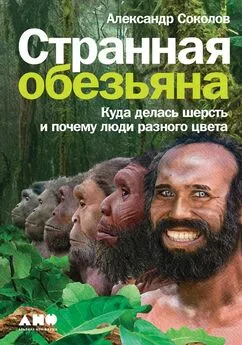Александр Соколов - Странная обезьяна [Куда делась шерсть и почему люди разного цвета]
- Название:Странная обезьяна [Куда делась шерсть и почему люди разного цвета]
- Автор:
- Жанр:
- Издательство:Альпина нон-фикшн
- Год:2020
- Город:Москва
- ISBN:978-5-0013-9316-0
- Рейтинг:
- Избранное:Добавить в избранное
-
Отзывы:
-
Ваша оценка:
Александр Соколов - Странная обезьяна [Куда делась шерсть и почему люди разного цвета] краткое содержание
Об этом и многом другом рассказывает в своей книге редактор портала АНТРОПОГЕНЕЗ.РУ Александр Соколов, еще раз доказывая, что наука — это потрясающе интересно и порой парадоксально.
Странная обезьяна [Куда делась шерсть и почему люди разного цвета] - читать онлайн бесплатно ознакомительный отрывок
Интервал:
Закладка:
9. De Beer S. G. Embryos and Ancestors. Clarendon Press, 1962, p. 51.
Глава 2. Шерсть, которую мы потеряли
1. Gilligan I. The Prehistoric Development of Clothing: Archaeological Implications of a Thermal Model // Journal of Archaeological Method and Theory (2010), 17: 15–80.
2. Сайт Московского зоопарка. Японский макак. http://www.moscowzoo.ru/animals/mlekopitayushchie/yaponskiy-makak/(дата обращения: 15.04.2020).
3. Inagaki H., Hamada Y. Differences in Hair Density of Japanese Monkeys (Macaca Fuscata Fuscata) with Localityand Age // Primates (Jan 1985), 26(1): 85–90.
4. Dunbar R. I. M. Group Size, Vocal Grooming and the Origins of Language // Psychonomic Societ y, Inc. (2016).
Глава 3. У кого волос меньше?
1. Schultz A. H. The Density of Hair in Primates // Human Biology (Sept 1931), 3 (3): 303–321.
2. Meyer-Lierheim F. Die Dichtigkeit der Behaarung beim Fetus des Menschen und der Affen // Zeitschrift für Morphologie und Anthropologie (1910), Bd. 13, H. 1: 131–150. Published by: E. Schweizerbart’sche Verlagsbuchhandlung.
3. Schwartz G. G. and Rosenblum L. A. Allometry of Primate Hair Density and the Evolution of Human Hairlessness // American Journal of Physical Anthropology (1981), 55 (1): 9–12.
4. Sandel A. A. Brief Communication: Hair Density and Body Mass in Mammals and the Evolution of Human Hairlessness // American Journal of Physical Anthropology (2013), 152: 145–150.
5. Szabo G. The Regional Anatomy of the Human Integument with Special Reference to the Distribution of Hair Follicles, Sweat Glands and Melanocytes // Philosophical Transactions of the Royal Society of London. B (1967), No. 779: 252, 447–485.
Глава 4. Но зачем?
1. Wallace A. R. Contributions to the Theory of Natural Selection. A Series of Essays. New York, 1872.
2. Соколов А. Б. Ученые скрывают? Мифы XXI века. — М.: Альпина нон-фикшн, 2018.
3. Darwin C. The Descent of Man, and Selection in Relation to Sex. New York: D. Appleton and Company, 1889, p. 56–58.
4. Соколов А. Б. Австралопитек хватался ногами за ветки, как современный человек // XX2 век. 2018. 17 декабря. https://22century.ru/allsorts/72754.
5. Соколов А. Б. Мягкие ткани австралопитека. Открытый научный проект // АНТРОПОГЕНЕЗ.РУ. 10.09.2011. http://antropogenez.ru/single-news/article/126/.
Глава 5. По одежке протягивай шерстку
1. Knight A. P. Hair // Queen’s Quarterly , 1904.
2. Glass B. Evolution of Hairlessness in Man // Science (1966), 152 (3720): 294.
3. Brace C. L., Hailman J. P., Kennington G. S., Hershkovitz Ph., Olson W. S. What Ever Happened to Hairy Man? // Science (1966), 153 (3734): 362–364.
4. Chatterjee S. K. The Pattern of Indian Clothing in Relation to Tropical Climate // Journal of Human Evolution (1978), 7: 95–99.
5. Gilligan I. Another Tasmanian Paradox: Clothing and Thermal Adaptations in Aboriginal Australia. BAR International Series. Oxford: Archaeopress, 2007.
6. Wyndham C. H. and Morrison J. F. Adjustment to Cold of Bushmen in the Kalahari Desert // Journal of Applied Physiology (1958), 13: 219–225.
7. Gilligan I., Bulbeck D. Environment and Morphology in Australian Aborigines: A Re-analysis of the Birdsell Database // American Journal of Physical Anthropology (2007), 134: 75.
8. Gilligan I. Clothing and Modern Human Behaviour: Prehistoric Tasmania as a Case Study // Archaeology in Oceania (Oct 2007), 42 (3): 102–111.
9. Kushlan J. A. The Evolution of Hairlessness in Man // American Naturalist (Nov 1980), 116 (5): 727–729.
10. Kushlan J. A. The Vestiary Hypothesis of Human Hair Reduction // Journal of Human Evolution (1985), 14: 29–32.
11. Chatterjee S. K. The Pattern of Indian Clothing in Relation to Tropical Climate // Journal of Human Evolution (1978), 7: 95–99.
12. Соколов А. Б. Из чего сшито пальто ледяного человека // АНТРОПОГЕНЕЗ.РУ. 24.08.2016. http://antropogenez.ru/single-news/article/588/.
13. Соколов А. Б. Неандертальцы были плохими портными? // XX2 век. 15.08.2016. https://22century.ru/allsorts/31315.
14. Carbonell E., García-Antón M., Mallol C., Mosquera M., Ollé A. The TD6 Level Lithic Industry from Gran Dolina, Atapuerca (Burgos, Spain): Production and Use // Journal of Human Evolution (1999), 37: 653–693.
15. Parésa J. M., Arnolda L., Duvala M., Demuroa M., Pérez-González A. Reassessing the Age of Atapuerca-TD6 (Spain): New Paleomagnetic Results // Journal of Archaeological Science (Deс 2013), 40 (12): 4586–4595.
16. Gilligan I. The Prehistoric Development of Clothing: Archaeological Implications of a Thermal Model // Published online (Jan 2010) # Springer Science+Business Media, LLC (2009).
17. Kittler R., Kayser M., Stoneking M. Molecular Evolution of Pediculus humanus and the Origin of Clothing // Current Biology (Aug 2003), 13 (16): 1414–1417. https://www.sciencedirect.com/science/article/pii/S0960982203005074(дата обращения: 15.04.2020).
18. Kittler R., Kayser M., Stoneking M. Molecular Evolution of Pediculus Humanus and the Origin of Clothing // Current Biology (Dec 2004), 14 (24): 2309.
19. Reed D. L., Smith V. S., Hammond S. L., Rogers A. R., Clayton D. H. Genetic Analysis of Lice Supports Direct Contact between Modern and Archaic Humans // PLoS Biology (Nov 2004), 2 (11): e340.
20. Light J. E., Toups M. A., Reed D. L. What’s in a Name: The Taxonomic Status of Human Head and Body Lice // Molecular Phylogenetics and Evolution (2008), 47: 1203–1216.
21. Соколов А. Б. Дом-0. Древнейшая история жилищ. Часть I // XX2 век. 18.08.2015. https://22century.ru/popular-science-publications/history_of_housing1.(дата обращения: 15.04.2020).
22. Moore J. D. The Prehistory of Home. Berkeley: University of California Press, 2012, р. 288.
23. Lumley H. de. A Paleolithic Camp at Nice // Scientific American (1969), 220: 42–50.
24. Villa P. Terra Amata and the Middle Pleistocene Archaeological Record of Southern France. Berkeley: University of California Press, 1983, р. 303.
25. Moore J. D. The Prehistory of Home. Berkeley: University of California Press, 2012, р. 288.
26. Demay L., Pean S., Patou-Mathis M. Mammoths Used as Food and Building Resources by Neanderthals: Zooarchaeological Study Applied to Layer 4, Molodova I (Ukraine) // Quaternary International (2012): 212–226, 276–277.
27. Roebroeks W., Villa P. On the Earliest Evidence for Habitual Use of Fire in Europe // PNAS (Mar 2011).
28. Соколов А. Б. В течение 700 тысяч лет люди в Европе не использовали огонь // АНТРОПОГЕНЕЗ.РУ. 17.03.2011. http://antropogenez.ru/single-news/article/70/.
Глава 6. А паразиты — никогда
1. Schedl W. Contribution to Insect Remains from the Accompanying Equipment of the Iceman. // Bortenschlager S., Oeggl K. D. The Iceman and his Natural Environment. New York, 2000, p. 151–155.
2. Belt T. The Naturalist in Nicaragua. London: Published by J. M. Dent & Sons Ltd. and in New York by E. P. Dutton & Co., 1874.
3. Стандарт мексиканской голой собаки // Сайт питомника мексиканских и перуанских голых собак Sonderwol Legend. 13.10.2010. https://www.sonderwol.com/standard/стандарт-мексиканской-голой-собаки/(дата обращения: 15.04.2020).
4. Darwin C. The Descent of Man, and Selection in Relation to Sex. New York: D. Appleton and Company, 1889, p. 57.
5. Lehmann T. Ectoparasites: Direct Impact on Host Fitness // Parasitology Today (1993), 9 (1).
6. Booth D. T., Clayton D. H. and Block B. A. Experimental Demonstration of the Energetic Cost of Parasitism in Free-Ranging Hosts // Proceedings of the Royal Society of London. B (1993): 125–129, 253.
7. Даррелл Д. Гончие Бафута. — М.: Центрполиграф, 2002.
8. Rantala M. J. Human Nakedness: Adaptation against Ectoparasites? // International Journal for Parasitology 29 (1999): 1987–1989.
9. Sutherland C. The Parasites of Homo sapiens — an Annotated Checklist of the Protozoa, Helminths and Arthropods for Which We Are Home // Parasite Immunology (2003), 25: 401.
10. Ashford R. W. Parasites as Indicators of Human Biology and Evolution // Journal of Medical Microbiology (2000), 49 (9): 771–772.
11. Tunga penetrans // Wikipedia. https://en.wikipedia.org/wiki/Tunga_penetrans.
12. Buckland P. C. and Sadler J. P. A Biogeography of the Human Flea, Pulex Irritans L. (Siphonaptera: Pulicidae) // Journal of Biogeography (Mar 1989), 16 (2): 115–120.
13. Hassanloo Z., Fenton M. B., DeLaurier J. D., and Eger J. L. Fur Increases the Parasite Drag for Flying Bats // Canadian Journal of Zoology (1995), Vol. 73.
14. Энциклопедия пилота. — М.: Редиздат ЦС Союза Осоавиахим СССР, 2011.
15. Rantala M. J. Evolution of Nakedness in Homo sapiens // Journal of Zoology (2007), 273: 1–7.
16. Pagel M. and Bodmer W. A Naked Ape Would Have Fewer Parasites // Proceedings of the Royal Society of London. B . (Aug 2003), 270.
17. Hamilton W. D., Zuk M. Heritable True Fitness and Bright Birds: a Role For Parasites? // Science (Oct 1982), 218 (4570): 384–7. https://www.ncbi.nlm.nih.gov/pubmed/7123238.
Читать дальшеИнтервал:
Закладка:
![Обложка книги Александр Соколов - Странная обезьяна [Куда делась шерсть и почему люди разного цвета]](/books/1066936/aleksandr-sokolov-strannaya-obezyana-kuda-delas-sh.webp)






